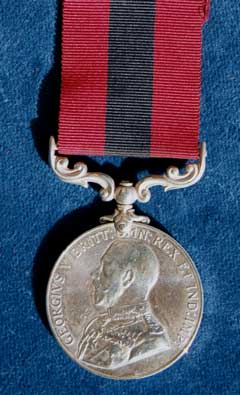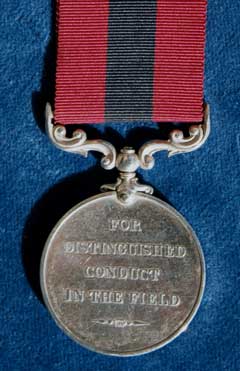MEDAL INFORMATION
Distinguished Conduct Medal
Face
On the Queen Victoria issues - a Trophy of Arms
incorporating a central shield bearing the Royal Coat of Arms. The
subsequent issues bear the head or bust of the reigning monarch surrounded
by an inscription: e.g. ‘GEORGIVS V BRITT: OMN: REX ET IND: IMP:’ Of
these there are seven types: EVIIR, GVR (uncrowned head), GVR (crowned
head), GVIR (first type), GVIR (second type), EIIR (first type), EIIR
(second type).
Reverse
The words ‘FOR DISTINGUISHED CONDUCT IN THE
FIELD’ in four lines with a small embellishment below.
Size
Approx. 36 mm diameter.
Composition
Medals and bars are of silver.
Ribbon
Approx. 32 mm wide. Crimson with a navy blue
central stripe approx. 10 mm wide.
Suspension
The ribbon passes through an ornamented, scroll
pattern, swivelling suspender.
Naming
All medals issued bear the recipient’s Number,
Rank, Name and Unit on the edge. The types of naming vary but, generally,
all awarded since 1914 are impressed.
Bar
A straight bar is awarded for each subsequent
act of distinguished conduct for which the Distinguished Conduct Medal
would have been awarded. Two types of bar have been issued; those awarded
between 1881 and mid-1916 bear the date of the subsequent award, those
awarded after mid-1916 bear a laurel-spray and no date.
Awarded
Instituted in 1854 as a reward to
Non-Commissioned Officers and men of the Army in the Crimean War for
‘distinguished, gallant and good conduct in the Field’. Before this there
had been no medal awarded by the British government in recognition of
individual acts of gallantry in the Army. The medal now ranks between the
Victoria Cross (instituted in 1856) and the Military Medal (instituted in
1916). Although it has, on occasion, been awarded to civilians, it has
never been awarded to a woman.
During
the reign of Queen Victoria, 2892 DCMs were awarded, including about 770
for the Crimean War and about 2050 for the South African (Boer) War (some
of these latter being the Edward VII type). For World War One around
25,000 were issued, whereas for World War Two only around 1900 awards
were made. In World War One single bar DCMs were fairly uncommon, but
very few men have been awarded the medal and two bars.
All
awards of the DCM are notified in the London Gazette, during World War One
citations were generally also published.
The
King’s Own
During the Crimean War, 1854-56, sixteen
Distinguished Conduct Medals were awarded to men of the 4th (King’s Own)
Regiment of Foot, and one was awarded for the Abyssinian Campaign, 1868.
In the South African (Boer) War, 1899-1902, there were twenty awards to
men of The King’s Own, and in World War One a further 136 awards, with two
men being awarded a bar to their medal. Another eight DCMs were awarded
in World War II.
On
Distinguished Conduct Medals awarded up to 1881 the shortened titles used
in the naming of the medals were: ‘4th REGT’; ‘4th REGT. OF FOOT’; or ‘4th
FOOT’; for medals awarded after 1881 and before 1920 ‘R. LANC. R.’ was
used. After 1920 when the title took its final form before amalgamation
lead to the forming of The King’s Own Royal Border Regiment, in 1959, the
shortened form appearing on medals was ‘KINGS OWN R’.
Distinguished Conduct Medal's in the museum's collection
The citations for Second World War
DCM Awards to the King’s Own can be found in the book ‘Heroic Deeds’
published by the Museum.


Distinguished Conduct Medal



